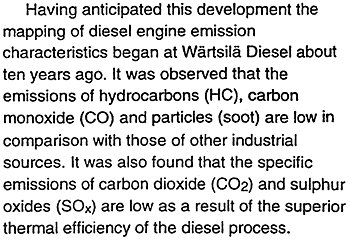Abstract
This paper discusses different diesel NOx control strategies for compliance with the IMO proposed global legislation and the restrictions that CARB and EPA have proposed for USA coastal waters. Low NOx Combustion, Direct Water Injection and Compact SCR Aftertreatment technologies are covered. Test results and installation related feedback are presented.
1. Introduction
Ever since its introduction, the diesel engine has proven to be a superior prime mover for converting fossil fuels into mechanical power. In recent decades industrial research and development have concentrated on performance and efficiency. Power density has more than doubled in the past twenty years and at the same time reliability has been greatly improved.
Present state-of-the-art large marine engines are approaching 50% thermal efficiency. Considering that Rudolf Diesel ran his first diesel engine with about 15% efficiency almost 100 years ago, we can only conclude that in terms of efficiency the development of the diesel engine has been a success story.
Those days are definitely past when thermal efficiency was the only criterion for successful engine R&D activity, since today environmental considerations are a very significant factor as well. The importance of this dimension will increase further in the years ahead as a result of ever more stringent environmental legislation and increasing awareness of 'green' issues.

Consequently, attention was gradually shifted to potential methods of reducing NOx emissions. The real challenge in recent years has been to develop diesel concepts which combine high efficiency with low emission levels. Fortunately, R&D in this field has been very successful. Low-NOx engines designed according to a totally new philosophy. Direct Water Injection and Compact Catalyst Aftertreatment, are now available to meet even the most stringent existing and anticipated marine environmental standards while having virtually no effect on fuel consumption.
2. IMO proposal for global marine NOx legislation
The BCH (Bulk Chemicals) sub-committee of the IMO/ MEPC (Marine Environmental Protection Committee within the International Maritime Organization) has the task of preparing international legislation for the control of NOx marine exhaust emissions. At the last BCH meeting in London on September 19-23, 1994 the "main text" was almost finalized for submission to MEPC. The "guidelines for application" was though partly left open. The MEPC is expected to finalize the work in September 1995. The final IMO decision on the new Annex to MARPOL is scheduled to be taken in February 1996.
It is proposed that the NOx legislation should cover only new ships and major engine modifications entering service after 1997 or 1998 (the date not decided on yet), existing ships are excluded.